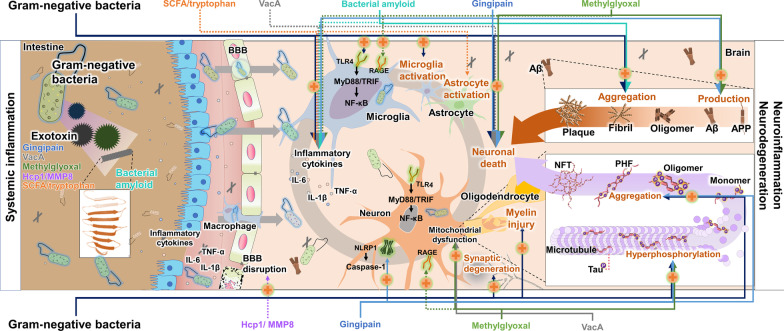Fig. 2.
The pathological mechanisms underlying the effect of gram-negative bacteria in Alzheimer’s disease. The gram-negative bacteria produce a variety of exotoxins, such as gingipain, methylglyoxal (MG), bacterial amyloid, vacuolating cytotoxin (VacA), bacterial amino-acid, heme carrier protein (Hcp1), matrix metalloproteinase-8 (MMP8), phosphorylcholine, short-chain fatty acid (SCFA), and tryptophan. The gram-negative bacteria and exotoxins can penetrate the BBB and affect the AD-related pathology. Concerning Aβ aggregation, MG and gingipain are involved in the increase of Aβ production; bacterial amyloid and gram-negative bacteria can induce Aβ aggregation. Concerning hyperphosphorylated tau and neurofibrillary tangles, gingipain, MG, and gram-negative bacteria can provoke the hyperphosphorylation of tau; gingipain and gram-negative bacteria can also promote the aggregation of phosphorylated tau. Concerning neuroinflammation, the Aβ-induced activation of microglia and astrocytes contributes to a neuroinflammatory response, affecting neurodegeneration. The gram-negative bacteria and gingipain can increase the release of inflammatory cytokines. Concerning neurodegeneration, gingipain, MG, and gram-negative bacteria can induce neuronal death. The gram-negative bacteria provoke neuronal loss through the activation of the neuronal TLR4 signaling pathway. Hcp1: Heme carrier protein; IL-6: Interleukin 6; IL-1β: Interleukin 1β; IL-18: Interleukin 18; MMP8: Matrix metalloproteinase-8; NLRP1: Nod-like receptor protein 1; RAGE: Receptor for advanced glycation end products; SCFA: Short-chain fatty acid; TNF-α: Tumor necrosis factor α; VacA: Vacuolating cytotoxin A

